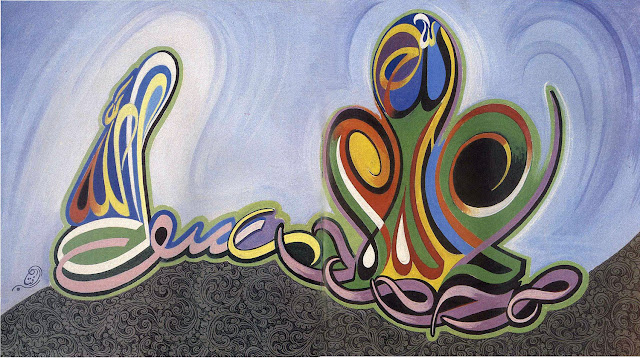
Calligraphy is the supreme art form of the Islamic world; even the other Islamic arts – architecture, metal work, ceramics, glass and textiles – draw on calligraphy as their principal source of embellishment.


The Shahada written in 13 different calligraphic styles
At a very early date, the characteristics
of the Arabic script, which indicates only consonants and to some extent
long vowels, were recognized, and a system of indicating – in writing –
short vowels, doubled consonants and so forth was developed. This
system consisted of a series of short marks placed above or below the
consonant, and indicated how it should be pronounced. At an even earlier
date, letters with similar shapes but different pronunciations had been
distinguished by the addition of one, two, or three dots above or below
the consonant in question. Otherwise, letters such as b, y, th, would have been indistinguishable.
The development of these matres lectionis was undertaken in
order to fix the canonical reading of the sacred text, to ensure that
when recited no variants might creep in and distort the word of God.
Calligraphers have always used these marks to enhance the beauty of
their compositions.The earliest form of Arabic script was probably derived from script used by the Nabateans (See Aramco World, September-October 1965). Called Kufic – after the town of Kufa in Iraq where it attained its most developed form – this script, with its square letter-forms, was perfectly suited to inscriptions on stone and metal, and so was widely used for commemorative inscriptions; it is still used for its decorative qualities.
During the late Umayyad and early Abbasid periods, the greatly increased literacy of the Islamic peoples, and the introduction of inexpensive writing materials – notably paper – led to the development of a number of different styles of calligraphy. More cursive scripts were invented because Kufic was unsuitable for quick notation, and the rules for writing these were codified by a series of famous calligraphers, particularly Ibn Muqla, Ibn Bawwab and Yaqut al-Musta’simi. These men, between the 10th and 13th centuries, laid the foundations for calligraphy, both as a tool of government and as an art form, but later – in the 15th, 16th and 17th centuries – the great calligraphers tended to come from Ottoman Turkey, Iran, Afghanistan and India. In all these places, new developments and styles were created, some for bureaucratic purposes, some for artistic.
It is not surprising, therefore, that even today many of the leading calligraphers of the Islamic world come from non-Arabic speaking areas. One example is Aftab Ahmad, of Peshawar in Pakistan – examples of whose work are presented in the following pages. The son of Muhammad Sharif, also a famous calligrapher, Aftab Ahmad is a man of many talents; an internationally recognized photographer, he is also a well-known ceramicist and calligrapher. Extraordinarily, he is ambidextrous and can write either from left to right or right to left with either hand.

The works of Islamic calligraphers, both past and present, are not always easy to decipher: although the form of individual letters must adhere to the rigid canons of whatever style is being used, clarity is not a paramount goal in artistic calligraphy. Part of the pleasure of looking at decorative calligraphy is the slow dawning of recognition, as the eye traces the letters and discovers a familiar text from the Koran. An example of how the words of a famous quotation are arranged by a master calligrapher, and how they must be read to attain their meaning, is given on this page.
Aftab Ahmad, although working firmly within the long-established tradition of Islamic calligraphy, has also added his own sense of color and movement. Each of his compositions is a work of art, and appeals to the viewer across linguistic and cultural boundaries.




No comments:
Post a Comment